-

中班语言课件教案:荷花开
2、启发幼儿根据儿歌的内容想象并用动作来表演。活动准备:1、带幼儿认识荷花,知道荷花的生长过程。2、与儿歌相应的图片。活动过程:一、欣赏荷花,幼儿说说荷花的主要特点和生长过程1、师:荷花是长在什么地方的呀?荷花的叶子是怎样的?荷花池里还会有什么呢?2、幼儿根据自己的知识经验讲述。二、结合图片学习儿歌《荷花开》1、出示图片:图上有什么?(小鱼、小虾、小雨还有风儿和荷花)2、老师把这张图片上的内容编成了一首好听的儿歌,大家一起来听一听吧!
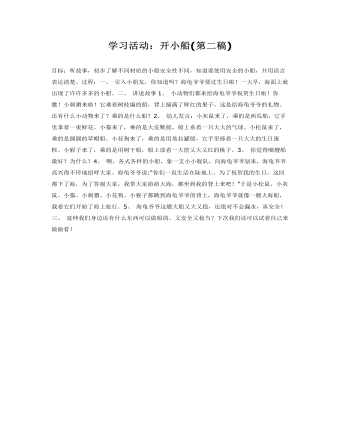
中班语言课件教案:开小船
二、讲述故事1、小动物们都来给海龟爷爷祝贺生日啦!你瞧!小刺猬来啦!它乘着树枝编的船,背上插满了鲜红的果子,这是给海龟爷爷的礼物。还有什么小动物来了?乘的是什么船?2、幼儿发言:小灰鼠来了,乘的是西瓜船,它手里拿着一束鲜花。小猫来了,乘的是大皮靴船,船上系着一只大大的气球。小松鼠来了,乘的是圆圆的草帽船。小花狗来了,乘的是用易拉罐船,它手里捧着一只大大的生日蛋糕。小猴子来了,乘的是用树干船,船上放着一大筐又大又红的桃子。
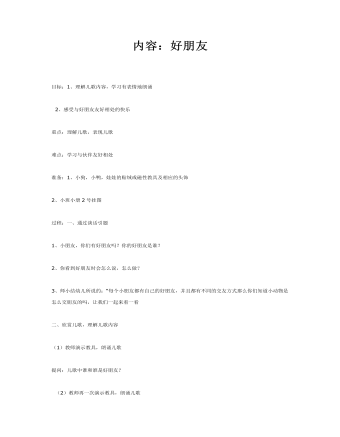
中班语言课件教案:好朋友
2、感受与好朋友友好相处的快乐重点:理解儿歌,表现儿歌难点:学习与伙伴友好相处准备:1、小狗,小鸭,娃娃的贴绒或磁性教具及相应的头饰2、小班小册2号挂图过程:一、通过谈话引题1、小朋友,你们有好朋友吗?你的好朋友是谁?2、你看到好朋友时会怎么说,怎么做?3、师小结幼儿所说的:“每个小朋友都有自己的好朋友,并且都有不同的交友方式那么你们知道小动物是怎么交朋友的吗,让我们一起来看一看

中班语言课件教案:家
3.让幼儿知道幼儿园是个大家庭,每个小朋友要关心爱护幼儿园。 1.画有蓝天、树林、草地、河水、花儿、幼儿园大幅背景图。 2.制作好的白云、小鸟、小羊、小鱼、蝴蝶、小朋友贴绒学具。 3.根据内容制作的头饰若干; 一、初步感知理解作品阶段 1.出示“家’’的背景图,尝试讨论:图上有哪些景物?它们各是谁的家?2.教师有感情地朗诵整首诗歌。3.让幼儿尝试一下白云、小鸟、小羊、小鱼、蝴蝶等回家的动作。4.教师指图朗诵,幼儿轻声跟念。5.倾听配乐诗歌《家》,要求幼儿倾听时想像诗歌的画面,也可尝试用身体动作表达自己的感受。二、反复聆听作品阶段幼儿在午睡前躺着聆听配乐诗歌录音,每次听两遍,4天左右,幼儿就能流畅背诵诗歌。
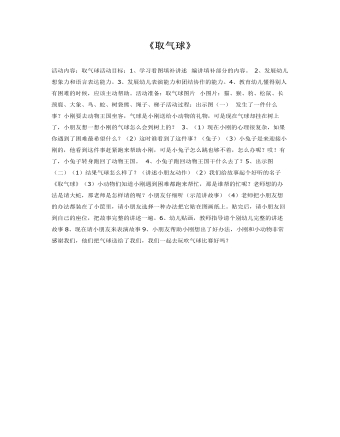
中班语言课件教案:取气球
4、教育幼儿懂得别人有困难的时候,应该主动帮助。活动准备:取气球图片 小图片:猫、猴、豹、松鼠、长颈鹿、大象、鸟、蛇、树袋熊、绳子、梯子活动过程:出示图(一) 发生了一件什么事?小刚要去动物王国坐客,气球是小刚送给小动物的礼物,可是现在气球却挂在树上了,小朋友想一想小刚的气球怎么会到树上的? 3、(1)现在小刚的心理很复杂,如果你遇到了困难最希望什么?(2)这时谁看到了这件事?(兔子)(3)小兔子是来迎接小刚的,他看到这件事赶紧跑来帮助小刚,可是小兔子怎么跳也够不着,怎么办呢?哎!有了,小兔子转身跑回了动物王国。 4、小兔子跑回动物王国干什么去了?5、出示图(二)(1)结果气球怎么样了?(讲述小朋友动作)(2)我们给故事起个好听的名子《取气球》
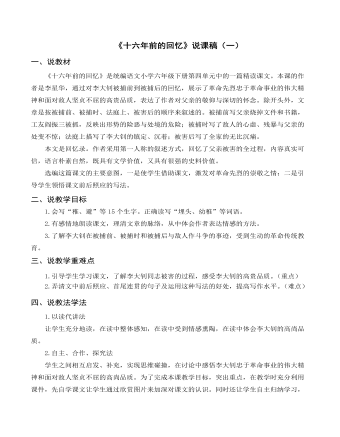
部编人教版六年级下册《十六年前的回忆》说课稿(一)
一、说教材《十六年前的回忆》是统编语文小学六年级下册第四单元中的一篇精读课文。本课的作者是李星华,通过对李大钊被捕前到被捕后的回忆,展示了革命先烈忠于革命事业的伟大精神和面对敌人坚贞不屈的高贵品质,表达了作者对父亲的敬仰与深切的怀念。除开头外,文章是按被捕前、被捕时、法庭上、被害后的顺序来叙述的。被捕前写父亲烧掉文件和书籍,工友阎振三被抓,反映出形势的险恶与处境的危险;被捕时写了敌人的心虚、残暴与父亲的处变不惊;法庭上描写了李大钊的镇定、沉着;被害后写了全家的无比沉痛。 本文是回忆录。作者采用第一人称的叙述方式,回忆了父亲被害的全过程,内容真实可信,语言朴素自然,既具有文学价值,又具有很强的史料价值。选编这篇课文的主要意图,一是使学生借助课文,激发对革命先烈的崇敬之情;二是引导学生领悟课文前后照应的写法。
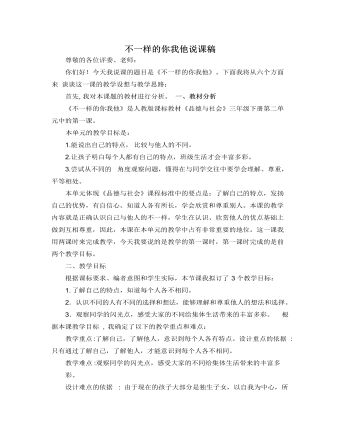
人教部编版道德与法制三年级下册不一样的你我他说课稿
学生画完后,将自己的作品贴在黑板上,并向大家讲述自己的想法。然后引导学生思考并讨论:大家同时在圆上作画,为什么画的不一样?(先由学生小组 讨论,然后学生派代表回答,最后老师引导学生归纳小结)通过大家在圆上作画,让学生知道,不同的人对同一件事情会有不同的想象。从而让学生得出结论:同学们的想法不一样。通过这个环节,激发学生想象,让学生自信并成功自己,欣赏、善待他人。活动三:“我们共同描绘五彩的花束” 我们的班级真是丰富多彩的班级,有着各具特色的你我他,老师很奇怪,如果让大家不同的想法集合在一起会怎么样呢?我们一起来试试吧!小组合作 在同一张纸上给花束上色并给它起一个具有你们小组特色的名字,画完欣赏完 的小组快速把图贴在黑板上。以上三个活动 围绕教学目标展开,每个活动都有目的,三个活动贯穿着逻 辑性,逐步提升。最后我说一说课后延伸环节。
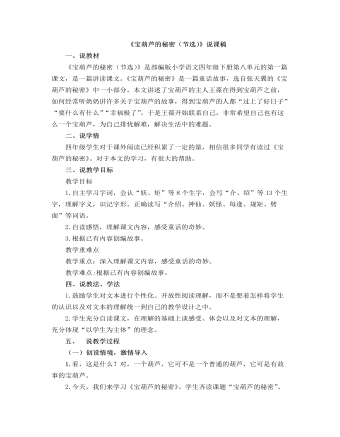
部编人教版四年级下册《 宝葫芦的秘密(节选)》说课稿
三、说教学目标教学目标1.自主学习字词,会认“妖、矩”等8个生字,会写“介、绍”等13个生字,理解字义,识记字形。正确读写“介绍、神仙、妖怪、每逢、规矩、劈面”等词语。2.自读感悟,理解课文内容,感受童话的奇妙。3.根据已有内容创编故事。教学重难点教学重点:深入理解课文内容,感受童话的奇妙。教学难点:根据已有内容创编故事。四、说教法、学法1.鼓励学生对文本进行个性化、开放性阅读理解,而不是想着怎样将学生的认识以及对文本的理解统一到自己的教学设计之中。2.学生充分自读课文,在理解的基础上谈感受、体会以及对文本的理解,充分体现“以学生为主体”的理念。
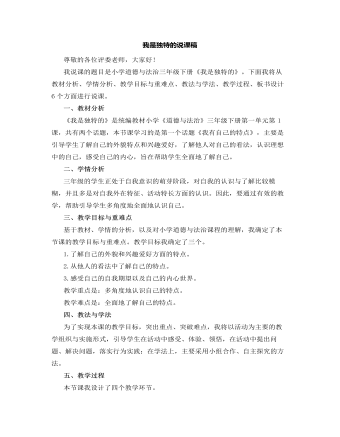
人教部编版道德与法制三年级下册我是独特的说课稿
学生阅读教材第5页阅读角,感受故事中主人翁的内心世界,再想一想“我的故事袋”中都装着哪些事情,其中有能够公开的,与大家分享。设计意图:深入感受自己丰富、独特的内心世界。环节三:感悟明理,育情导行学生谈一谈学习本节课的收获,教师相机引导。设计意图:梳理总结,体验收获与成功的喜悦,内化提升学生的认识与情感。环节四:拓展延伸,回归生活回家后,向爸爸妈妈讲一讲独特的自己。设计意图:将课堂所学延伸到学生的日常生活中,有利于落实行为实践。六、板书设计为了突出重点,让学生整体上感知本节课的主要内容,我将以思维导图的形式设计板书:在黑板左半面的中间位置是课题《我是独特的》,右半面分四行,找一找自己、他人眼中的自己、期望中的自己、我独特的内心世界。其中,找一找自己分为两方面:外貌 独一无二 本领 各不相同;他人眼中的自己,我认可。
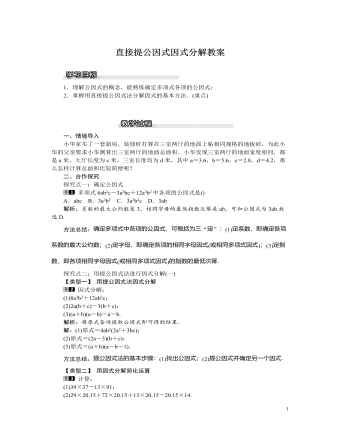
北师大初中八年级数学下册直接提公因式因式分解教案
解析:(1)首先提取公因式13,进而求出即可;(2)首先提取公因式20.15,进而求出即可.解:(1)39×37-13×91=3×13×37-13×91=13×(3×37-91)=13×20=260;(2)29×20.15+72×20.15+13×20.15-20.15×14=20.15×(29+72+13-14)=2015.方法总结:在计算求值时,若式子各项都含有公因式,用提取公因式的方法可使运算简便.三、板书设计1.公因式多项式各项都含有的相同因式叫这个多项式各项的公因式.2.提公因式法如果一个多项式的各项有公因式,可以把这个公因式提到括号外面,这种因式分解的方法叫做提公因式法.本节中要给学生留出自主学习的空间,然后引入稍有层次的例题,让学生进一步感受因式分解与整式的乘法是逆过程,从而可用整式的乘法检查错误.本节课在对例题的探究上,提倡引导学生合作交流,使学生发挥群体的力量,以此提高教学效果.
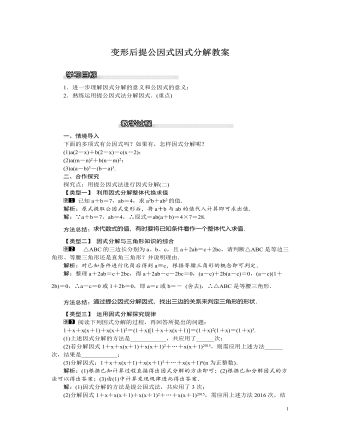
北师大初中八年级数学下册变形后提公因式因式分解教案
(3)分解因式:1+x+x(x+1)+x(x+1)2+…+x(x+1)n(n为正整数).解析:(1)根据已知计算过程直接得出因式分解的方法即可;(2)根据已知分解因式的方法可以得出答案;(3)由(1)中计算发现规律进而得出答案.解:(1)因式分解的方法是提公因式法,共应用了3次;(2)分解因式1+x+x(x+1)+x(x+1)2+…+x(x+1)2015,需应用上述方法2016次,结果是(1+x)2015;(3)1+x+x(x+1)+x(x+1)2+…+x(x+1)n=(1+x)n+1.方法总结:解决此类问题需要认真阅读,理解题意,根据已知得出分解因式的规律是解题关键.三、板书设计1.提公因式分解因式的一般步骤:(1)观察;(2)适当变形;(3)确定公因式;(4)提取公因式.2.提公因式法因式分解的应用本课时是在上一课时的基础上进行的拓展延伸,在教学时要给学生足够主动权和思考空间,突出学生在课堂上的主体地位,引导和鼓励学生自主探究,在培养学生创新能力的同时提高学生的逻辑思维能力.
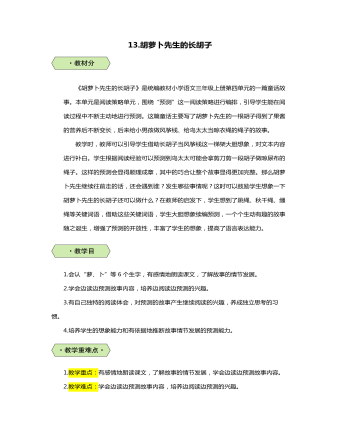
统编版三年级语文上胡萝卜先生的长胡子教案
1.胡萝卜先生的胡子可真长啊!胡萝卜先生继续走着,接下来会发生什么有趣的事情呢?(学生发挥想象,预测接下来的故事情节。) 2.自读课文第4-8自然段,看看与你们自己的预测一样不一样吧!学生自己读故事,发现自己的预测和文本内容不一样时及时修正自己的想法。(1)出示关键句:线实在太短了,他的风筝只能飞过屋顶。根据课文内容,预测接下来的故事发展。(2)出示关键句:鸟太太正在找绳子晾小鸟的尿布。根据插图中鸟太太遇见胡萝卜先生惊喜的神态,预测接下来的故事发展。 3.文章写完了吗?为什么?(结尾的省略号就告诉我们这个故事还没有结束。) 既然没有结束,我们就来续编故事吧!可以结合上面的男孩的语言、动作续编故事,也可以有自己新奇的想法。大家之前预测的故事发展只要合乎情理也可以继续预测。
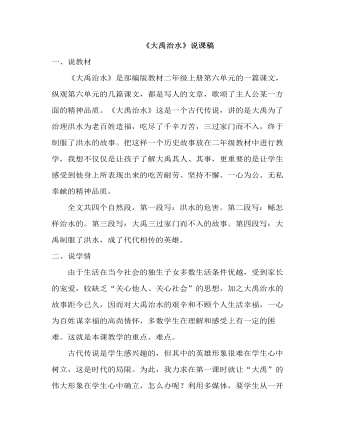
部编人教版二年级上册《大禹治水》说课稿
一、说教材《大禹治水》是部编版教材二年级上册第六单元的一篇课文,纵观第六单元的几篇课文,都是写人的文章,歌颂了主人公某一方面的精神品质。《大禹治水》这是一个古代传说,讲的是大禹为了治理洪水为老百姓造福,吃尽了千辛万苦,三过家门而不入,终于制服了洪水的故事。把这样一个历史故事放在二年级教材中进行教学,我想不仅仅是让孩子了解大禹其人、其事,更重要的是让学生感受到他身上所表现出来的吃苦耐劳、坚持不懈、一心为公、无私奉献的精神品质。全文共四个自然段,第一段写:洪水的危害。第二段写:鲧怎样治水的。第三段写:大禹三过家门而不入的故事。第四段写:大禹制服了洪水,成了代代相传的英雄。
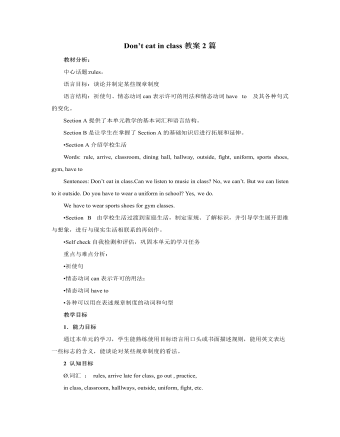
人教版新目标初中英语七年级下册Don’t eat in class教案2篇
Don’t fight. =You can’t fight. (板书,教读)教师把这些句子板书在黑板上,并请学生大声整齐地读祈使句和“can’t”句型,并让学生注意两种句型表达形式的不同和转换,“Don’t …=You can’t…”;并对学生说:These are our school rules. (板书,教读) You can’t break the school rules. Don’t break the school rules.(板书,教读)步骤3 :Practicea. T: Now, each of the students is breaking one of these rules.Please finish 1a.学生看图,完成1a的内容,检查答案并大声朗读校规。b. 听录音,完成1b,选出四位学生都违反了哪条校规;听之前,学生要读会英文名。c. 请两位学生朗读1c部分的句型;要求学生两人一组对话表演,SA扮演外校转来新生,SB告知本校校规。(学生可经过讨论,多说出他们想到的校规,不必只限于书上;教师应给予帮助)2) 第二课时(2a~4)步骤1 :warming up of revisionT: What are the rules at your school?学生使用“can”或祈使句表达各条校规;其中老师可引出“eat in the cafeteria outside”的表达。步骤2 :Practicea.T: Christina is an exchange student. She doesn’t know the rules. Let’s listen, what activities they’re talking about?学生听第一遍时,完成2a;第二遍时,完成2b;b. 请学生领读2c部分,看着2a完成的表格,理解2c活动的要求;分成小组针对2a进行问答;
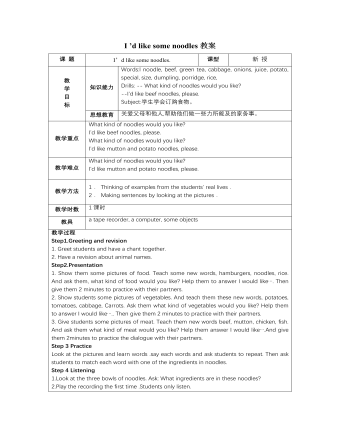
人教版新目标初中英语七年级下册I ’d like some noodles教案
教学过程Step 1: warming-up Sing a song---------“food and drink” Step 2: Revision1 Dictation2 Revise: What kind of noodles would you like?I’d like …What size bowl of noodles would you like?I’d like…Step 3: Presentation1 show pictures of food, ask students say the words.2 Students read the newspaper ad in 3a. Fill in blanks with words in the box. Then read the ad together, the teacher explains some difficult language points.3 Check the answers Step 4 PracticeAsk students to finish 3b in the same way according to 3a. Students read the short passage and fill in the blanks .At last, check the answers.Step 5 productionAsk students to write their own ad for dumplings, noodles, drinks, and other foods they know. Then ask students to read their partner’s ad. Then order food and drink from their partner.Step 6 Home workGroup work – make an ad about “food and drink”
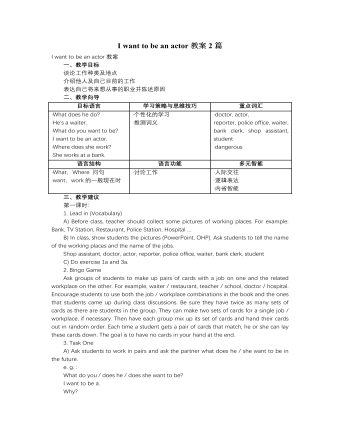
人教版新目标初中英语七年级下册I want to be an actor教案2篇
三、教学建议第一课时:1. Lead in (Vocabulary)A) Before class, teacher should collect some pictures of working places. For example: Bank, TV Station, Restaurant, Police Station, Hospital ...B) In class, show students the pictures (PowerPoint, OHP). Ask students to tell the name of the working places and the name of the jobs.Shop assistant, doctor, actor, reporter, police office, waiter, bank clerk, studentC) Do exercise 1a and 3a.2. Bingo GameAsk groups of students to make up pairs of cards with a job on one and the related workplace on the other. For example, waiter / restaurant, teacher / school, doctor / hospital. Encourage students to use both the job / workplace combinations in the book and the ones that students came up during class discussions. Be sure they have twice as many sets of cards as there are students in the group. They can make two sets of cards for a single job / workplace, if necessary. Then have each group mix up its set of cards and hand their cards out in random order. Each time a student gets a pair of cards that match, he or she can lay these cards down. The goal is to have no cards in your hand at the end.3. Task OneA) Ask students to work in pairs and ask the partner what does he / she want to be in the future.e. g. :What do you / does he / does she want to be?I want to be a.Why?Because it's (adj).B) Vocabulary: Section B, 1a4. Homework 1.2.
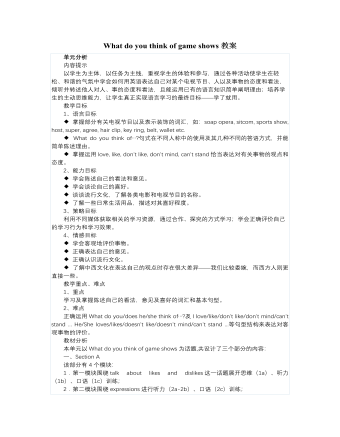
人教版新目标初中英语七年级下册What do you think of game shows教案
五、教学Section B-2c1. Pair work: What do you think of the belt/sunglasses/…? What does your father/mother/… think of your scarf/belt…?2. Group work(1). Teacher shows some different kinds of school uniforms (制服)and asks : “ What do you think of your school uniforms? If you have a chance to choose your school uniforms, what kind would you like to choose?”(2). Discuss in groups.(3).Get some Ss to report in class.说明:这一步旨在让学生运用已有的语言知识谈论对事物的看法和意见,并简单阐明理由,培养学生的主动思维能力和运用英语的能力。六、教学拓展调查电视节目的收视率任务:调查你周围的人对现在各种电视节目的反响。活动过程:1.教师布置任务,让学生调查周围的人(包括他的亲戚朋友和邻居)喜欢收看哪方面的电视节目。2.学生进行调查活动,运用本单元所学的句型What do you think of….? (Why?)What's your favorite game shows?What do you think of talk show?I doesn’t mind it.I like it.I love it.I can’t stand it.3.记录下排在前10位的TV Program,填写调查表,比较其收视率。

人教版新目标初中英语七年级下册Where did you go on vacation教案
句型: Where did you go on vacation? I went to summer camp.Did she go to Central Park?Yes,she did.No, she didn’t语法:一般过去时特殊疑问句、一般疑问句及肯、否定回答。课时安排4课时第一课时:Section A:la,1b,lc,2a,2b,2c 第二课时:Section A:3a,3b,4第三课时:Section B:1,2a,2b,2c第四课时:Section B:3a,3b,3c,4 and Self Check第一课时教学目标掌握描写假期生活的形容词。假期里自己所做事情的简单表达。谈论假期做的事情及当时情况。谈论假期时旅游的天气,旅游者以及食物等。教学过程一、导入播放一首英文歌曲:Let’s travel 说明:通过让学生听节奏欢快迪斯尼英语歌曲Let’s travel.引入本节课谈论的话题vacation and travel. 让歌曲使学生的思维活跃,增强课堂气氛,激发学生提高学习英语的兴趣。T:How is the trip ?Ss : It’s pretty good/ happy/exciting /relaxing/busy/dangerous/ fantastic说明:这个问题是为了操练形容词。建议让多个Ss作答。鼓励他们用不同的形容词。上述个别形容词本应在第二课时中出现,但可以在warming-up中第一次非正式出现。这些形容词也可在老师的评价语中适时出现,以加深学生对词汇的印象。
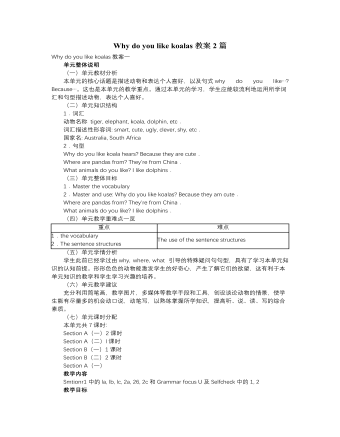
人教版新目标初中英语七年级下册Why do you like koalas教案2篇
单元整体说明(一)单元教材分析本单元的核心话题是描述动物和表达个人喜好,以及句式why do you like…? Because…。这也是本单元的教学重点。通过本单元的学习,学生应能较流利地运用所学词汇和句型描述动物,表达个人喜好。(二)单元知识结构1.词汇动物名称 tiger, elephant, koala, dolphin, etc.词汇描述性形容词: smart, cute, ugly, clever, shy, etc.国家名: Australia, South Africa2.句型Why do you like koala hears? Because they are cute.Where are pandas from? They're from China.What animals do you like? I like dolphins.(三)单元整体目标1.Master the vocabulary2.Master and use: Why do you like koalas? Because they am cute.Where are pandas from? They're from China.What animals do you like? I like dolphins.(四)单元教学重难点一览(五)单元学情分析学生此前已经学过由why, where, what 引导的特殊疑问句句型,具有了学习本单元知识的认知前提。形形色色的动物能激发学生的好奇心,产生了解它们的欲望,这有利于本单元知识的教学和学生学习兴趣的培养。
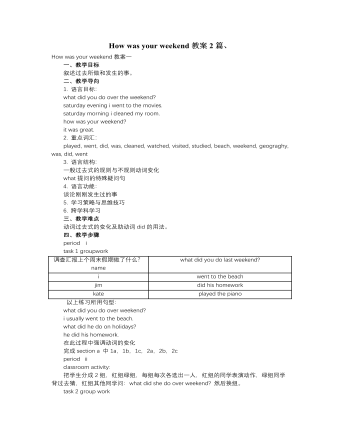
人教版新目标初中英语七年级下册How was your weekend教案2篇
Teaching Goal:1. General aims:Talk about recent past events2. Particular aims:A. Language Focus.Talk about recent past events and think of the past events.B. Language goalsHow was….?It was …What did …do over the weekend?C. Language structures:(1). How was your weekend? I was great. Pay attention to no form.(2). What did you do over the weekend? I played soccer. We went to the beach.D. Useful words and phrases:Words: was, did, went, beach, over, project, test, wasn’t, false, number, geography, spend, week, most, mixture, their, had, little, cook, read, saw, change, everyone, sit, sat, no, anythingPhrases: did one’s homework, played soccer, cleaned my room, went to the beach, played tennis, went to the movies, on Saturday morning, over the weekend, cook … for, what about, do some reading, have a party, talk show, go shoppingE. Grammar language:Present simple past tenseRegular and irregular verbsF. Learning strategies:Tour and holidaysG. Interdiscipinary:H. Emotion and manner:Teaching time: 5 periodsTeaching procedures:Period One教学步骤、时间 教师活动 学生活动 媒体应用Step 1Free talk 3’ Ask some questions like:Who’s on duty today?What’s the weather like? Answer and talk about something.让同学们回答下列问题1. Do you like weekend? (Let some students answer)It takes them three minutes to talk about the question.2. Why do you like weekend? (let the students answer) Most of the students like the weekend此时教师用汉语问:“在周末期间问你干了什么?这句话用英语这么回答?Let the students guess.At last the teacher give them right answer3. What did you do over the weekend?(板书、学习)

